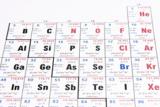Two lists have special significance to water quality regulatory programs in the Clean Water Act (CWA):
Toxic Pollutants
Key Features
- The Clean Water Act references the Toxic Pollutant List at section 307(a)(1); 33 U.S.C. 1317(a)(1).
- The list appears in the Code of Federal Regulations at 40 CFR 401.15.
- The list is an important starting point for EPA to consider, for example, in developing national discharge standards (such as Effluent Guidelines) or in national permitting programs (such as NPDES).
- The list contains 65 entries. Many of the entries, such as "haloethers," are for groups of pollutants.
Relationship between CWA Section 307(a)(1) and the Toxic Pollutant List
- Section 307(a)(1) says:
...the list of toxic pollutants or combination of pollutants subject to this Act shall consist of those toxic pollutants listed in table 1 of Committee Print Numbered 95-30 of the Committee on Public Works of the House of Representatives…
- Committee Print 95-30 (November 1977) is titled "Data Relating to H.R. 3199 (Clean Water Act of 1977)."
- Table 1 is titled "Section 307—Toxic Pollutants." EPA incorporated Table 1 into the Code of Federal Regulations at 40 CFR 401.15.
History of the Toxic Pollutant List
- Source of the list: The list was negotiated among parties to a settlement agreement (NRDC et al. vs Train, 6 ELR 20588 Exit, D.D.C. June 9, 1976).
- That settlement agreement is sometimes referred to as the "Toxics Consent Decree" or the "Flannery Decision" (for presiding U.S. District Court Judge Thomas A. Flannery).
- Congress subsequently ratified the Settlement Agreement and the toxic pollutant list when it amended the CWA in 1977 (Public Law 95-217, December 27, 1977).
- Background document:
Copeland, Claudia. Congressional Research Service (1993). "Toxic Pollutants and the Clean Water Act: Current Issues." Report No. 93-849. Exit - The list was first published on January 31, 1978 in the Federal Register (43 FR 4108).
- In a final rule on July 31, 1979 (44 FR 44501), EPA published the list again and added the list to the CFR at 40 CFR 401.15.
Modifications
- EPA removed three pollutants from the list in 1981, after determining that their chemical properties did not justify their inclusion:
- Dichlorodifluoromethane and trichlorofluoromethane were de-listed on January 8, 1981 (46 FR 2266) at the request of E.I. duPont de Nemours and Co. because of low solubility in water and high volatility combined with low human and mammalian toxicity. Bis(chloromethyl) ether was de-listed on February 4, 1981 (46 FR 10723) based on data that indicated a half-life in water of 38 seconds at 20°C.
- De-listing the three pollutants did not change the 65 entries because the three de-listed pollutants were specific compounds within entries for the groups Halomethanes (list entry 38) and Haloethers (list entry 37).
Priority Pollutants
Overview
Key features of the Priority Pollutant List and its relationship to the Toxic Pollutant List:
- The Priority Pollutants are a set of chemical pollutants EPA regulates, and for which EPA has published analytical test methods.
- The Priority Pollutant List makes the list of toxic pollutants more usable, in a practical way, for the purposes assigned to EPA by the Clean Water Act. For example, the Priority Pollutant list is more practical for testing and for regulation in that chemicals are described by their individual chemical names. The list of toxic pollutants, in contrast, contains open-ended groups of pollutants, such as "chlorinated benzenes." That group contains hundreds of compounds; there is no test for the group as a whole, nor is it practical to regulate or test for all of these compounds.
Derivation
Starting with the list of toxic pollutants, EPA used four criteria to select and prioritize specific pollutants:
- We included all pollutants specifically named on the list of toxic pollutants;
- There had to be a chemical standard available for the pollutant, so that testing for the pollutant could be performed;
- The pollutant had to have been reported as found in water with a frequency of occurrence of at least 2.5%, and
- The pollutant had to have been produced in significant quantities, as reported in Stanford Research Institute's "1976 Directory of Chemical Producers, USA."
Number of Entries
Originally, there were 129. When three pollutants were removed from the list of toxic pollutants in 1981 (see "Modifications" above), they were also removed from the Priority Pollutant List.
- Entry numbers 17, 49, and 50 were removed.
- The last number on the list is still 129, although there are 126 entries.
Publication
Q: Why is the Priority Pollutant List published at 40 CFR Part 423, Appendix A, rather than at Part 401, or some other, more general section?
You will need Adobe Reader to view some of the files on this page. See EPA’s About PDF page to learn more.
- One of the first industrial categories for which EPA developed Effluent Guidelines was the Steam Electric Power Generating Category (40 CFR Part 423). The Priority Pollutant List was included to support regulations for that category.
- Although the other sections within Part 423 apply only to the Steam Electric Power Generating Category, the Priority Pollutant List in Appendix A is not limited in terms of its relevance to that one industrial category.
- Some users find it helpful to think of Appendix A to Part 423 as a convenient storage place for the list, or as a matter of convenience for citation.
- Priority Pollutant List (PDF)(2 pp, 47 K, 2014)

